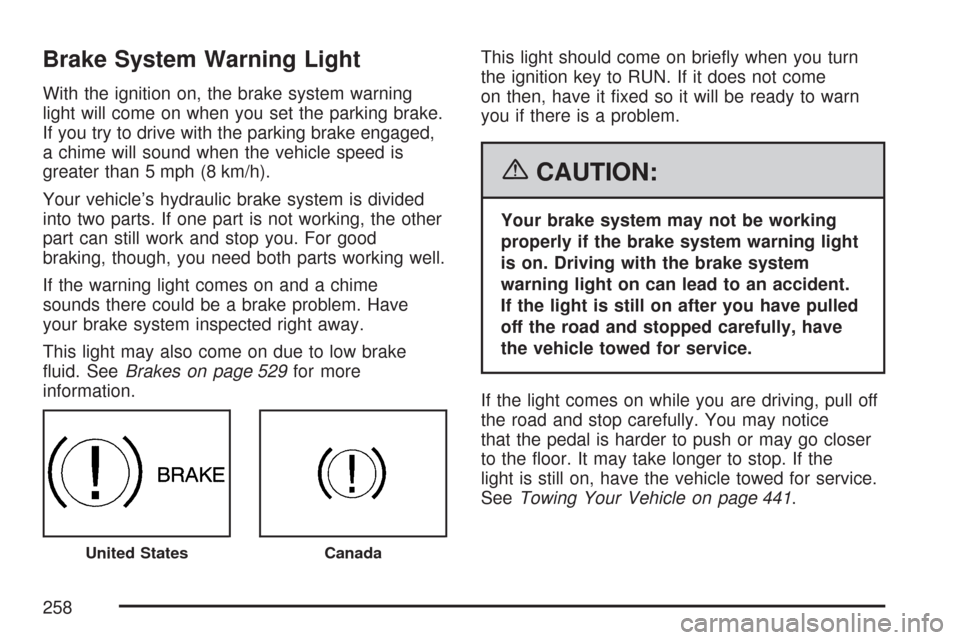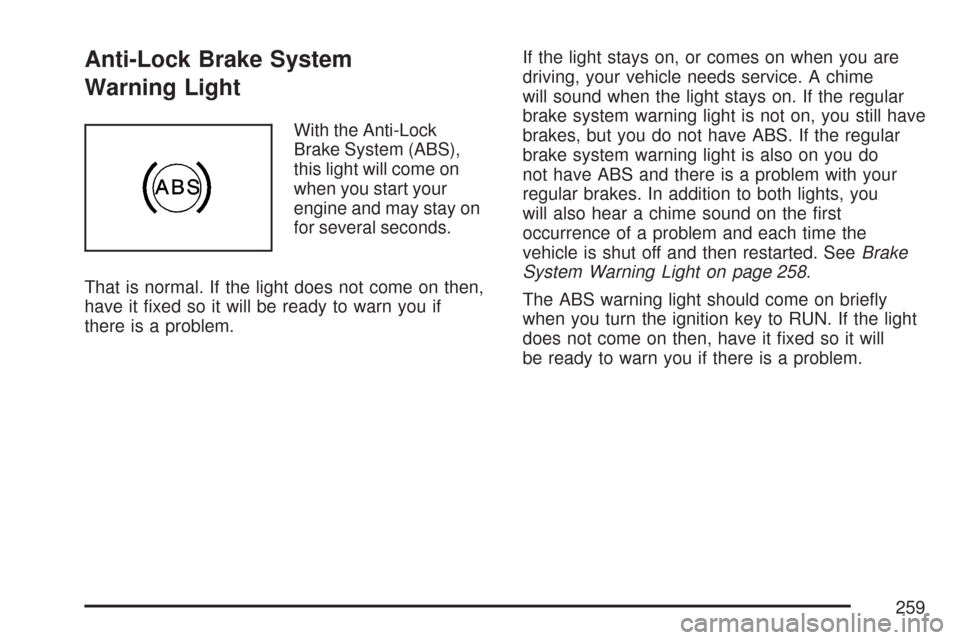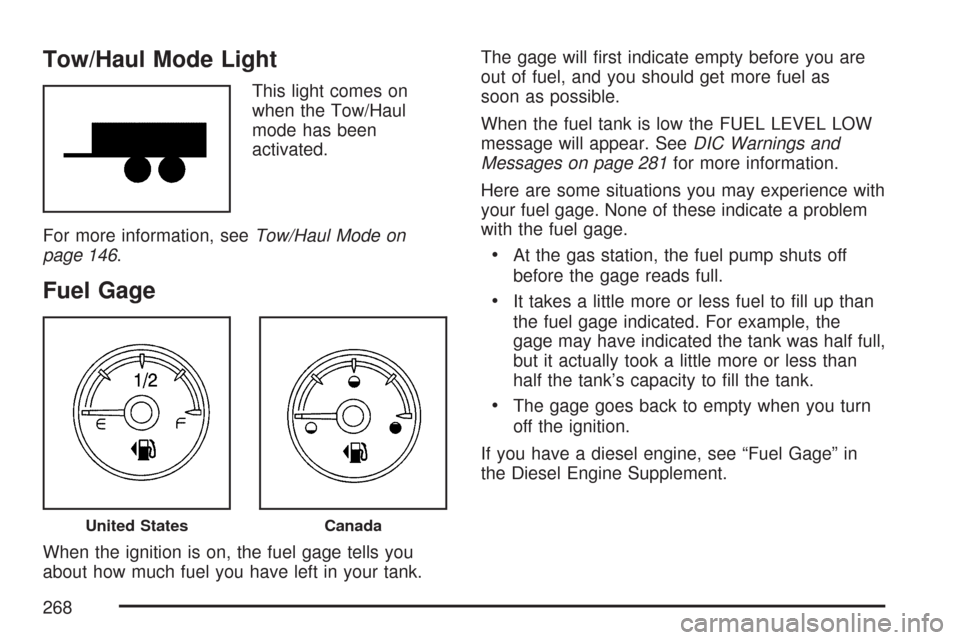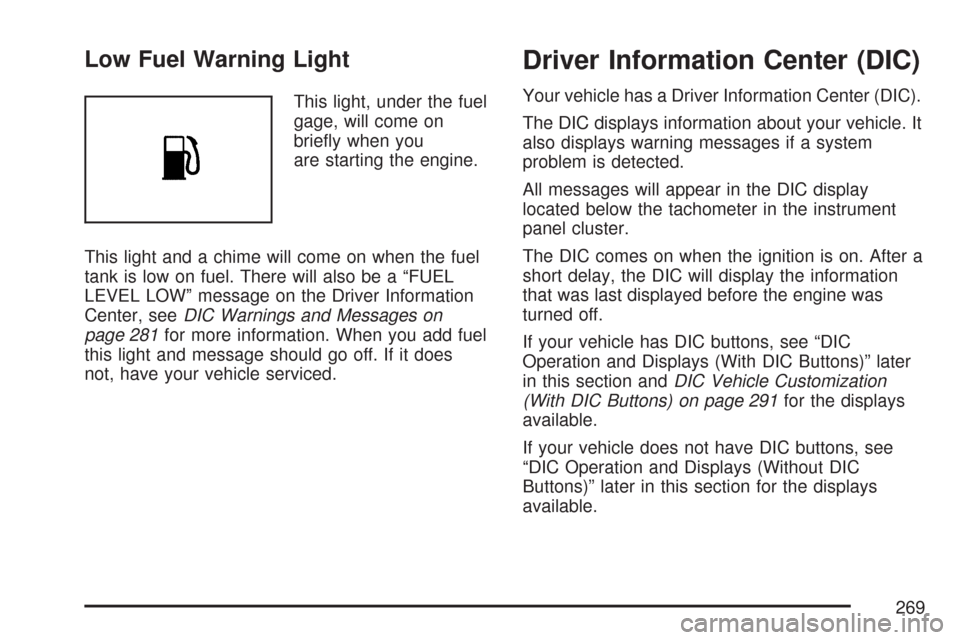Page 248 of 684

Warning Lights, Gages, and
Indicators
This part describes the warning lights and gages on
your vehicle. The pictures help to locate them.
Warning lights and gages can signal that something
is wrong before it becomes serious enough to
cause an expensive repair or replacement. Paying
attention to the warning lights and gages could also
save you or others from injury.
Warning lights come on when there may be or is a
problem with one of your vehicle’s functions. As
the details show on the next few pages, some
warning lights come on brie�y when you start the
engine just to let you know they are working. If
you are familiar with this section, you should
not be alarmed when this happens.Gages can indicate when there may be or is a
problem with one of your vehicle’s functions. Often
gages and warning lights work together to let
you know when there is a problem with your
vehicle.
When one of the warning lights comes on and
stays on as you are driving, or when one of
the gages shows there may be a problem, check
the section that tells you what to do about it.
Please follow this manual’s advice. Waiting to do
repairs can be costly and even dangerous. So
please get to know your vehicle’s warning
lights and gages. They can be a big help.
Your vehicle also has a Driver Information Center
(DIC) that works along with warning lights and
gages. SeeDIC Warnings and Messages
on page 281for more information.
248
Page 258 of 684

Brake System Warning Light
With the ignition on, the brake system warning
light will come on when you set the parking brake.
If you try to drive with the parking brake engaged,
a chime will sound when the vehicle speed is
greater than 5 mph (8 km/h).
Your vehicle’s hydraulic brake system is divided
into two parts. If one part is not working, the other
part can still work and stop you. For good
braking, though, you need both parts working well.
If the warning light comes on and a chime
sounds there could be a brake problem. Have
your brake system inspected right away.
This light may also come on due to low brake
�uid. SeeBrakes on page 529for more
information.This light should come on brie�y when you turn
the ignition key to RUN. If it does not come
on then, have it �xed so it will be ready to warn
you if there is a problem.
{CAUTION:
Your brake system may not be working
properly if the brake system warning light
is on. Driving with the brake system
warning light on can lead to an accident.
If the light is still on after you have pulled
off the road and stopped carefully, have
the vehicle towed for service.
If the light comes on while you are driving, pull off
the road and stop carefully. You may notice
that the pedal is harder to push or may go closer
to the �oor. It may take longer to stop. If the
light is still on, have the vehicle towed for service.
SeeTowing Your Vehicle on page 441.
United StatesCanada
258
Page 259 of 684

Anti-Lock Brake System
Warning Light
With the Anti-Lock
Brake System (ABS),
this light will come on
when you start your
engine and may stay on
for several seconds.
That is normal. If the light does not come on then,
have it �xed so it will be ready to warn you if
there is a problem.If the light stays on, or comes on when you are
driving, your vehicle needs service. A chime
will sound when the light stays on. If the regular
brake system warning light is not on, you still have
brakes, but you do not have ABS. If the regular
brake system warning light is also on you do
not have ABS and there is a problem with your
regular brakes. In addition to both lights, you
will also hear a chime sound on the �rst
occurrence of a problem and each time the
vehicle is shut off and then restarted. SeeBrake
System Warning Light on page 258.
The ABS warning light should come on brie�y
when you turn the ignition key to RUN. If the light
does not come on then, have it �xed so it will
be ready to warn you if there is a problem.
259
Page 260 of 684

StabiliTrak®Indicator Light
If equipped, this warning
light should come on
brie�y when the engine
is started.
If the warning light does not come on then, have it
�xed so it will be ready to warn you if there is a
problem. If it stays on, or comes on when you are
driving, there may be a problem with your
StabiliTrak
®system and your vehicle may need
service. When this warning light is on, the system
is off and will not limit wheel spin. Adjust your
driving accordingly.
This light will also �ash when the StabiliTrak
®
system is active.
If the StabiliTrak
®system warning light comes on
and stays on for an extended period of time
when the system is turned on, your vehicle needs
service. SeeStabiliTrak
®System on page 384
for more information.
Engine Coolant Temperature Gage
This gage shows the engine coolant temperature.
It also provides an indicator of how hard your
vehicle is working. During a majority of the
operation, the gage will read 210°F (100°C) or
less. If you are pulling a load or going up hills, it is
normal for the temperature to �uctuate and go
over the 235°F (113°C) mark. However, if the gage
reaches the 260°F (125°C) mark, it indicates
that the cooling system is working beyond
its capacity.
SeeEngine Overheating on page 517.
United StatesCanada
260
Page 261 of 684
Tire Pressure Light
This light comes on
brie�y when you turn
the ignition to RUN.
This light will also come on when one or more of
your tires are signi�cantly underin�ated.A CHECK TIRE PRESSURE message in the
Driver Information Center (DIC) will accompany
the light. SeeDIC Warnings and Messages
on page 281for more information.
Stop and check your tires as soon as it is safe to
do so. If underin�ated, in�ate to the proper
pressure. SeeTires on page 552for more
information.
This light will �ash for approximately 60 seconds
and then stay on if a problem is detected with
the Tire Pressure Monitor system.
SeeTire Pressure Monitor System on page 563
for more information.
261
Page 265 of 684

Oil Pressure Gage
Your vehicle may have an engine oil pressure
gage. It shows the engine oil pressure in psi
(pounds per square inch) when the engine is
running. Canadian vehicles indicate pressure in
kPa (kilopascals).
Oil pressure may vary with engine speed, outside
temperature and oil viscosity, but if readings
are outside the normal operating range, the oil
pressure light will come on. SeeOil Pressure Light
on page 266for more information.A reading outside the normal operating range may
be caused by a dangerously low oil level or
some other problem causing low oil pressure.
Check your oil as soon as possible. See
“OIL PRESSURE LOW” underDIC Warnings and
Messages on page 281andEngine Oil (Gasoline
Engine) on page 502.
{CAUTION:
Do not keep driving if the oil pressure is
low. If you do, your engine can become so
hot that it catches �re. You or others could
be burned. Check your oil as soon as
possible and have your vehicle serviced.
Notice:Lack of proper engine oil maintenance
may damage the engine. The repairs would
not be covered by your warranty. Always follow
the maintenance schedule in this manual for
changing engine oil.United StatesCanada
265
Page 268 of 684

Tow/Haul Mode Light
This light comes on
when the Tow/Haul
mode has been
activated.
For more information, seeTow/Haul Mode on
page 146.
Fuel Gage
When the ignition is on, the fuel gage tells you
about how much fuel you have left in your tank.The gage will �rst indicate empty before you are
out of fuel, and you should get more fuel as
soon as possible.
When the fuel tank is low the FUEL LEVEL LOW
message will appear. SeeDIC Warnings and
Messages on page 281for more information.
Here are some situations you may experience with
your fuel gage. None of these indicate a problem
with the fuel gage.
At the gas station, the fuel pump shuts off
before the gage reads full.
It takes a little more or less fuel to �ll up than
the fuel gage indicated. For example, the
gage may have indicated the tank was half full,
but it actually took a little more or less than
half the tank’s capacity to �ll the tank.
The gage goes back to empty when you turn
off the ignition.
If you have a diesel engine, see “Fuel Gage” in
the Diesel Engine Supplement.
United StatesCanada
268
Page 269 of 684

Low Fuel Warning Light
This light, under the fuel
gage, will come on
brie�y when you
are starting the engine.
This light and a chime will come on when the fuel
tank is low on fuel. There will also be a “FUEL
LEVEL LOW” message on the Driver Information
Center, seeDIC Warnings and Messages on
page 281for more information. When you add fuel
this light and message should go off. If it does
not, have your vehicle serviced.
Driver Information Center (DIC)
Your vehicle has a Driver Information Center (DIC).
The DIC displays information about your vehicle. It
also displays warning messages if a system
problem is detected.
All messages will appear in the DIC display
located below the tachometer in the instrument
panel cluster.
The DIC comes on when the ignition is on. After a
short delay, the DIC will display the information
that was last displayed before the engine was
turned off.
If your vehicle has DIC buttons, see “DIC
Operation and Displays (With DIC Buttons)” later
in this section andDIC Vehicle Customization
(With DIC Buttons) on page 291for the displays
available.
If your vehicle does not have DIC buttons, see
“DIC Operation and Displays (Without DIC
Buttons)” later in this section for the displays
available.
269